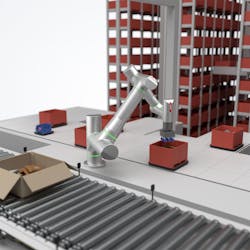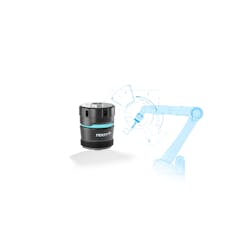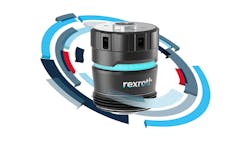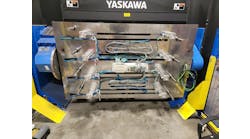And then there were three.
Beckhoff, Bosch Rexroth and ACS Climatics are the finalists for the annual Hermes Award, which will be announced and presented by Germany’s Federal Minister of Education and Research Bettina Stark-Watzinger, in the presence of German Chancellor Olaf Scholz, during the opening ceremony of Hannover Messe on April 16.
The Hermes Award recognizes a product or solution that demonstrates a particularly high degree of technological innovation that has already been proven in industrial practice. Entries for the award and the Hermes Startup Award, which will also be announced, were accepted through February 15.
An independent jury representing government, business, research and society at large, chaired by Prof. Dr.-Ing. Reimund Neugebauer, president of the Fraunhofer Society, narrowed down the large field of submissions to name the three finalists. The winner will be selected from this group based on the degree of technological innovation; benefits for industry, the environment and society; and cost-effectiveness and implementation maturity.
“Once again, the quality of the submissions this year was very impressive,” explained Neugebauer. “With a sensor-based balancing module for robots, a modular industrial robot construction kit and a multi-user platform for building management, the nominees brilliantly demonstrated their innovative strength with efficient, sustainable and flexible solutions. All three of these solutions have the potential to dynamically shape their respective fields and to bring about lasting change in their areas of application. On behalf of the jury, I wish all three nominees every success in their future endeavors.”
The Beckhoff ATRO—Automation Technology for Robotics project—is a modular industrial-robot-building kit that can be used to individually and flexibly assemble optimal robot structures for a number of applications (Figure 1). Standardized motor modules with integrated drive functionality, together with link modules in various designs and lengths, enable a wide range of mechanical combinations. The complete integration of the controller into the holistic TwinCAT control platform makes a wide range of proven automation functions directly available.
“This recognition as a Hermes Award finalist is further evidence that Beckhoff’s future in robotics is bright with ATRO,” said Matt Prellwitz, drive technology product manager, Beckhoff Automation, who explained the modular robotic approach to Control Design. “We are excited to forever change how the world thinks about industrial robots.”
The modular ATRO system is designed to enable extreme flexibility in robot kinematics to fit essentially any application with payloads up to 10 kg and reach of up to 1.3 meters. With ATRO, users can select the exact number of axes required and assemble the robot or cobot needed for the application. And the internal media feeds for data, power and fluids are designed to support continuous rotation of all robot axes.
With a variety of modules, ATRO is designed to give users the power to create almost any custom robot design within the rated payloads for the application—from a simple single-axis rotary-indexing-table application and delta kinematics up to multi-axis articulated robots.
Configurations with as many as 16 robotic arms are possible. The adapted structures are scanned by the control software, and the TwinCAT robotics functions create the corresponding control application, including a digital twin. Robot teaching with ATRO is accomplished by the user moving the custom-assembled robot arm into the desired positions and setting them via a user interface.
This robotics approach also is designed to ensure simple commissioning and handling because the robot system is based on EtherCAT and integrated into PC-based control technology, meaning only one industrial PC is needed, even for multiple robots.
ATRO kinematics are made up of active joints—motor modules—available in different designs: straight modules in I-shape or angled modules in L-shape, which are designed in five power sizes. Each motor module forms a complete drive system for one axis of the robot. External components—a power supply and a controller—are required.
All modules are interconnected via the ATRO interface, which is designed to guarantee a rigid mechanical connection along with reliable, continuous media feeds. Data, power and other lines, such as compressed air, vacuum or water are guided internally through the ATRO kinematics modules. Each axis can rotate endlessly, which eliminates interfering contours due to external cables and interfering torques.
Integration into standard TwinCAT automation software and EtherCAT allows a variety of functions concentrated in one control environment, so ATRO also can be combined with intelligent transport solutions such as XTS and XPlanar.
Bosch Rexroth’s Smart Flex Effector is a sensor-based compensation module—end effector—for robots with independent, precise kinematics in six degrees of freedom (Figure 2).
The Smart Flex Effector is designed to give robots and Cartesian linear systems human-like sensitivity. Processes that are difficult to manage can be automated, optimized and monitored through retrofitting. The tactile device with sensitive touch records the position of the work piece and passes the information to the robot control unit for active compensation purposes.
For machine manufacturers, it opens up a range of applications, including passive compensation units, force torque sensors and visual systems. The applications range from process automation and quality monitoring to teaching and the controlled handling of objects.
The Smart Flex Effector is designed to correct processes with great complexity and tight tolerances, such as in the case of positional deviations between the tool and the work pieces or in complex joining processes with minimal tolerances. And, thanks to the 6D position recording, the robotic control system can read the coordinates for gripping and placing points directly. Repeated learning during operation is possible in an automated manner.
Even parts made of glass or other fragile materials can be handled. The compensation module also can be actively moved into the zero position and electromechanically locked for fast transfer runs.
The Smart Flex Effector offers an RS-485 interface, as well as an I/O interface for exchanging data. For a passive compensation function, the Smart Flex Effector is screwed to the robot flange and the gripper. The locking function and data transmission are available as soon as the unit is connected to the power supply and the control system.ACS Climatics is a multi-user platform for building management. Digital-twin technologies with machine-learning algorithms are used to increase the energy efficiency of buildings. For this purpose, the measurement data of heating, ventilation and air conditioning are collected in a single device with high temporal resolution. Since this is a learning system, the sensor data is run through a plausibility check. Using this system, energy savings of an average 25% can be achieved through the optimized interaction of all the climate-determining variables.
The 2022 Hermes Award went to Sumitomo Cyclo Drive Germany. The company won the award for its fully integrated drive system for robot applications and automation technology. Features included the gear unit, motor and driver with safety functions. The product’s sensor technology and thermal management made it suitable for high-precision, sensitive applications in service robotics, as well as for interaction with humans. The modular concept and modular systems enabled an application-specific configuration of the required hardware.
In 2022, the Hermes Startup Award went to MIP Technology. The award-winning project involved a magnetic identification solution as an alternative to optically readable codes and RFID tags.
Hannover Messe will take place April 17-21 in Germany. This year’s partner country is Indonesia.








